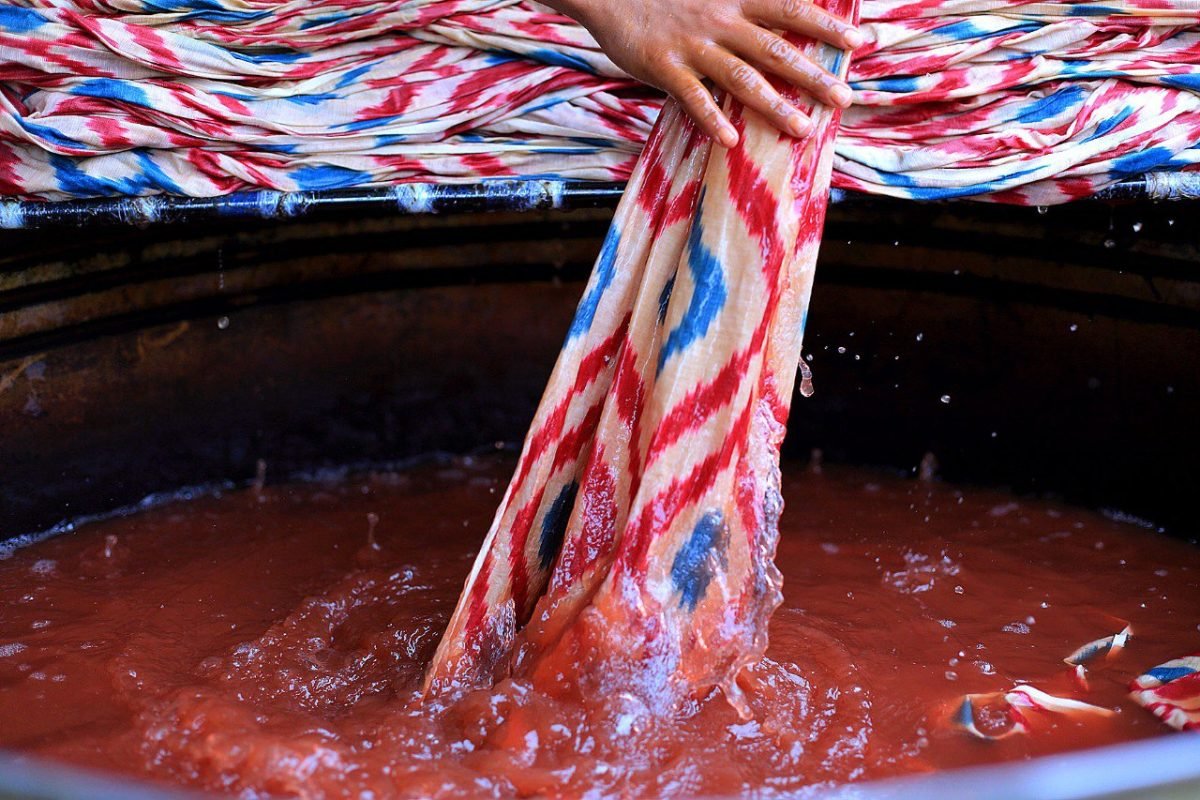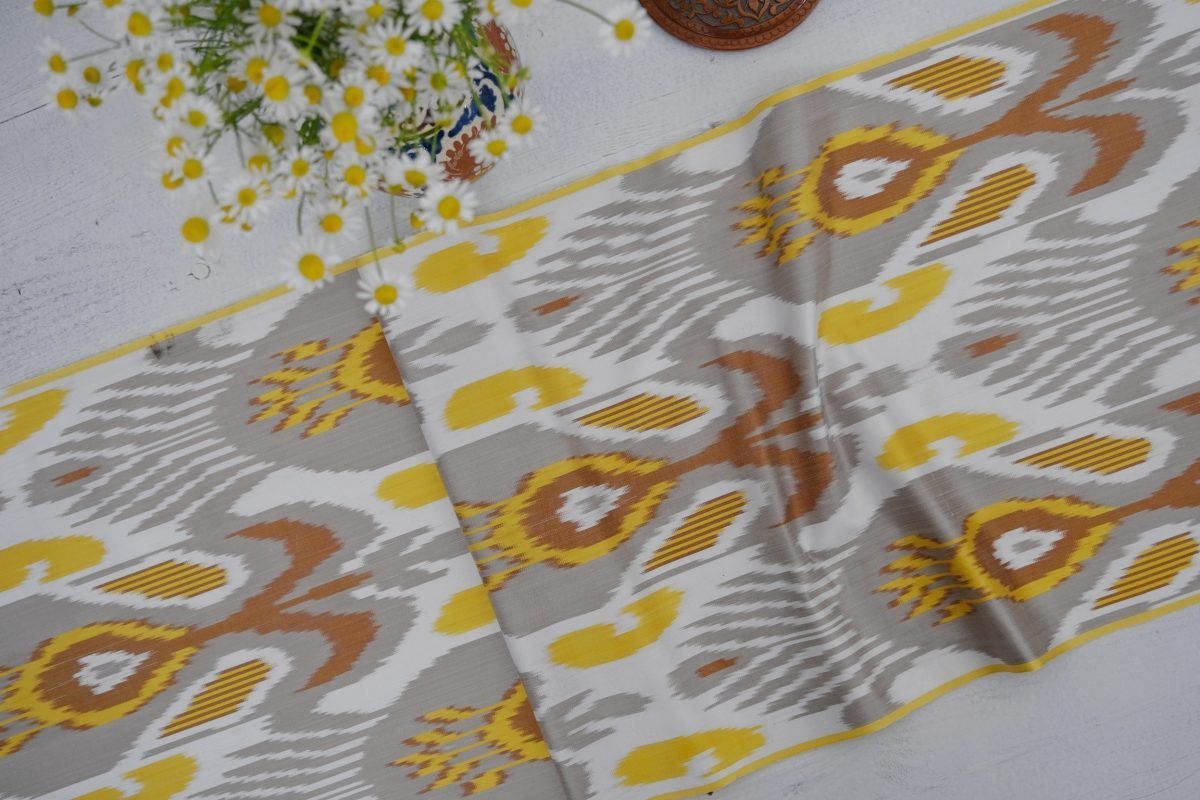The most beautiful textiles in the world are Uzbek ikat and suzani. Glossary of Uzbek fabrics
There are at least two unique Uzbek textiles – suzani and ikat. Susanis are embroidered in silk or cotton with bright motifs, including cloves, pomegranates, irises, tulips and discs representing the sun or moon.
Describing the motives and all the beauty of the Uzbek ikat, one can emphasize their bewitching magnificence. They are amazing – somehow “relaxed”, improvised, aerated, but also dreamy, unusually elegant.

In Central Asia, ikat textiles bring great prestige not only because of the laborious technique of its manufacture and high cost, but because the final product is insanely beautiful. In Uzbekistan, an ikat coat, called a chapan or bathrobe, has been and continues to represent the social status and wealth of its owner.
Glossary of Uzbek fabrics
Abru Bahor – an ancient technique that originated in Bukhara and in translation means “spring clouds”. The essence of the technique is to apply a picture by mixing various paints. The result is a marble tint with smooth and at the same time unpredictable transitions from one color to another. Sources say that on the backgrounds received, decrees of Bukhara rulers were written earlier, book covers were made out. Over time, the Abru Bahor technique was transferred from Bukhara to India, Iran and Turkey. Especially popular “abru bahor” was in the XV-XVII century. A special role in the preservation and improvement of this technique was played by artists not only from Uzbekistan, but also from Turkey.
Adras – a fabric consisting of 50% silk, 50% cotton. Adras keeps it cool in the summer and gives off heat in the winter.
Atlas – a soft, dense, silk fabric with a smooth shiny front surface.
Batik – a hand-painted fabric technique. Translated from the Indonesian language, batik means “to cover with drops.”
Bakhmal – is a velvet fabric with a silk pile, the basis of which is silk and cotton.
Bekasam – is a striped fabric made of cotton and silk, widely used for sewing men’s chapan and cotton blankets in the past. The fabric is dyed by hand. Recently, the fabric has acquired a new sound in modern collections of young Uzbek designers.
Bosma – manual technique of making suzani. The Bosma style is embroidered with one-sided satin stitch. Bosma has various variations.
Coarse calico – cotton fabric.
Gas – a translucent, lightweight, silk fabric.

Ikat is a fabric manufacturing technique. In Uzbekistan, the fabrics obtained in this way are called abra. Fabrication using ikat technology includes up to forty stages. It all starts with cooking silk pupae in hot water. In this case, the caterpillar must die inside the cocoon. If the silkworm comes out of the cocoon, the thread will be spoiled. Next, they begin to bundle bundles of threads for their phased dyeing in certain colors. The peculiarity of the Uzbek ikat is that the pattern is applied only to the warp threads, while the ducks remain monochrome. This is a complex, manual process. Fabrics of the same composition may differ slightly in density of weaving of threads, it depends on the pattern, the thickness of the threads, as well as the individual weaving technique of each weaver. The uniqueness of the ikat technique does not allow you to create two identical fabrics!
Iroki – hand-made technique suzani. The “iroki” style is embroidered with a dense cross or half-cross with twisted threads. The “Iroki” style is mainly used in Shakhrisabz (Kashkadarya region, Uzbekistan).
Islimi is a type of relief carving that originated in Central Asia. A characteristic feature of this thread is the location of the pattern above the background, which creates the impression of a thin lace covering the product. The pattern, as a rule, is a floral or geometric ornament.

Karakul – is a fur removed from lambs usually on the third day after birth. Astrakhan non-dyed fur is black and colored. Thanks to the individual curl pattern of each astrakhan skin, all models from karakul can be called exclusive. Today karakul is divided into three groups: Uzbek, Afghan and South African.
Karakulcha are skins of unborn lambs, obtained approximately two weeks before the time of birth. Karakulcha differs from karakul in not fully formed curls and thinner leather tissue. Karakulcha is especially appreciated due to its unique silkiness and softness.
Kilim – handmade woolen lint-free carpet. Kilim originates in Ancient Persia. It is known that it was on the territory of this state that about 2500 years ago the first oriental carpet was woven. Translated from Persian “gilim” – “roughly made blanket.” The carpet was woven mainly from camel hair. The kilim production technology since ancient times is widespread in Uzbekistan.
Crepe is a group of silk fabrics made from crepe twist threads and peculiar weaves. The most common types of crepe fabrics: crepe de chine, crepe satin, crepe chiffon.
Organza – a transparent, thin, slightly harsh fabric woven from silk, polyester or viscose.
Sur – astrakhan fur with uneven color. The color at the tip of the pile is lighter, at the root acquires a more intense color.
Suzani is a hand-embroidered textile. In Uzbekistan, suzane is recognized as one of the most ancient types of needlework.

Tual – natural silk fabric with plain weave and soft shine.
Zarduzlik – embroidery with “golden” threads. Bukhara has always been the center of gold sewing in Uzbekistan. The most common format is embroidery on velvet in different colors. The embroidery was carried out with a very thin and narrow gilded strip of metal – kalebatuns, tightly wound on a silk or paper thread. At the end of the nineteenth century, Bukhara craftsmen began to use the gimp — a thin gold or silver thread called “lycak”. Patterns and paints of wall paintings of the VI-VII centuries. indicate the existence of gold embroidery in the early Middle Ages.
Chiffon – silk, thin, matte, rough to the touch fabric.
Shoyi – thin, soft, silk fabric.
Excelsior – thin, transparent, smooth, silk fabric
Jurma is a handmade technique of suzani, also known as a chain stitch, which involves creating a pattern with a special hook.

